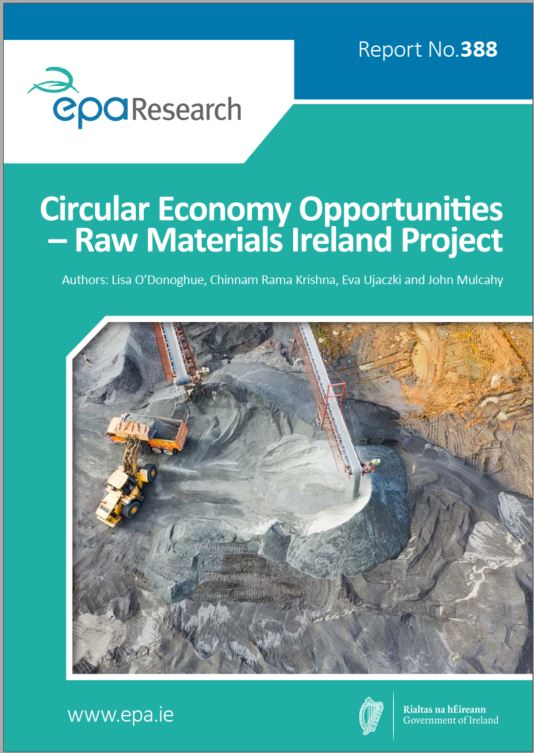Research 388: Circular Economy Opportunities – Raw Materials Ireland Project
Authors: Lisa O’Donoghue, Chinnam Rama Krishna, Eva Ujaczki and John Mulcahy
Summary: Ireland is home to primary industries in mining, materials processing and power generation. Today, most waste outputs associated with these industries are either sent for disposal or exported. The research focused on techniques for mechanical and physical separation, to unlock valuable materials such as iron, aluminium, calcium and critical raw materials (gallium, indium and phosphorus).

Project Highlights
Watch the project highlights video
Identifying Pressures
Ireland is home to primary industries in mining, materials processing and power generation. Today, the majority of waste outputs associated with these industries are either sent for disposal or exported. There is, however, potential to assess these wastes as secondary raw materials, recover any valuable metals and find alternative applications for the end waste that can contribute to a circular economy. In the light of this, the high-level objectives of the Raw Materials Ireland Project are defined as follows:
- to unlock the value of various metals from mining and industrial residues;
- to push Ireland to the forefront in the area of raw materials processing technologies;
- to improve the economic viability and investment security of processing operations.
The specific objectives to achieve these are to:
- undertake characterisation of certain waste from the mining, materials processing and power generation sectors;
- investigate synergies between the different wastes regarding composition;
- investigate the critical raw material (CRM) content of the wastes and synergies that exist;
- develop strategies for the recovery of valuable materials;
- investigate separation techniques to recover any valuable metals and CRMs.
Informing Policy
A detailed waste inventory and characterisation study of 24 waste samples from 12 different industrial sites across Ireland was undertaken as follows:
- mine waste rock and tailings: Lisheen Mine, Silvermines, Avoca Mines, Galmoy Mine, Two Valleys Mines Tara Mines and Tynagh Mine;
- power plant fly ash and bottom ash: Electricity Supply Board (ESB) Moneypoint, ESB Lough Ree, ESB West Offaly, Covanta Dublin Waste to Energy and Indaver waste to energy;
- Refinery residue: Aughinish Alumina.
The results of the analysis revealed commonalities among a group of valuable materials and CRMs that were present in the majority of the wastes as follows:
- metals – iron (~50–200 g/kg), zinc (~10–300 g/kg), aluminium (~10–50 g/kg) and calcium (~100–270 g/kg);
- CRMs – gallium, indium and phosphorus (typically ~0.1–0.2 g/kg).
The development of an initial waste inventory with detailed composition of national wastes is key to informing Irish policymakers of the secondary raw materials resources available and the potential contributions they can make to circular economy.
Developing Solutions
The recovery strategy developed focused on separating the wastes into the following concentrated fractions:
- base metals – to separate iron, zinc and aluminium phases from the main fraction;
- calcium-rich phase – to concentrate the remaining calcium-rich fraction, which may have applications in the construction sector;
- CRMs – to track the locations of the CRMs within the separated fractions and any potential for downstream concentration of these elements.
The research focused on techniques for mechanical and physical separation, such as ball milling and filtration, magnetic separation, dissolution studies and gravity separation processes, including the Mozley superpanner and the multi-gravity separator (MGS). The test results showed that the gravity separation techniques gave the best results where individual wastes demonstrated enhanced responses for either the Mozley superpanner or the MGS, based on their specific characteristics.
Process flows based on the results were developed for specific market applications for the wastes, including cement clinker replacement, cement filler, aggregates and geopolymer applications.
The process flows illustrate processing steps to unlock the valuable materials including base metals and the calcium rich-fractions. In addition, a process flow for multiple wastes was developed to showcase a circular economy approach where the scaling of the process and the capability to co-process different wastes augment the economic viability of the operation.
https://www.epa.ie/media/epa-2020/research/epa-funded-research/Report-cover-388.jpg